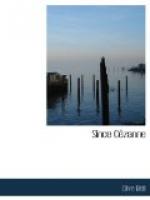To save ourselves from absurdity, and still more to save our painters from inspissating that trickle of fatuity which wells from heads swollen with hot air, critics should set themselves to check this nasty malady. Let them make it clear that to talk of modern English painting as though it were the rival of modern French is silly. In old racing days—how matters stand now I know not—it used to be held that French form was about seven pounds below English: the winner of the Derby, that is to say, could generally give the best French colt about that weight and a beating. In painting, English form is normally a stone below French. At any given moment the best painter in England is unlikely to be better than a first-rate man in the French second class. Whistler was never a match for Renoir, Degas, Seurat, and Manet; but Whistler, Steer, and Sickert may profitably be compared with Boudin, Jongkind, and Berthe Morisot. And though Duncan Grant holds his own handsomely with Marchand, Vlaminck, Lhote, de Segonzac, Bracque and Modigliani, I am not yet prepared to class him with Matisse, Picasso, Derain, and Bonnard.
Having bravely recognized this disagreeable truth, let us take as much interest in contemporary British painting as we can. I will try to believe that it merits more enthusiasm than I have been able to show, provided it is not made a point of patriotism to excite oneself about the Imperial War Museum’s pictures exhibited at Burlington House. As a matter of fact, the most depressing thing about that show was the absence of the very quality for which British art has been most justly admired—I mean sensibility. Mr. Wilson Steer’s picture seemed to me the best in the place, just because Mr. Steer has eyes with which, not only to see, but to feel. To see is something; Mr. Steer also feels for what he sees; and this emotion is the point of departure for his pictures. That he seems almost completely to have lost such power as he ever had of giving to his vision a coherent and self-supporting form is unfortunate; still, he does convey to us some modicum of the thrill provoked in him by his vision of Dover Harbour.
Those thoughtful young men, on the other hand, whose works have been causing such a commotion might almost as well have been blind. They seem to have seen nothing; at any rate, they have not reacted to what they saw in that particular way in which visual artists react. They are not expressing what they feel for something that has moved them as artists, but, rather, what they think about something that has horrified them as men. Their pictures depart, not from a visual sensation, but from a moral conviction. So, naturally enough, what they produce is mere “arty” anecdote. This, perhaps, is the secret of their success—their success, I mean, with the cultivated public. Those terrible young fellows who were feared to be artists turn out after all to be innocent Pre-Raphaelites. They leave Burlington House without a stain upon their characters.




